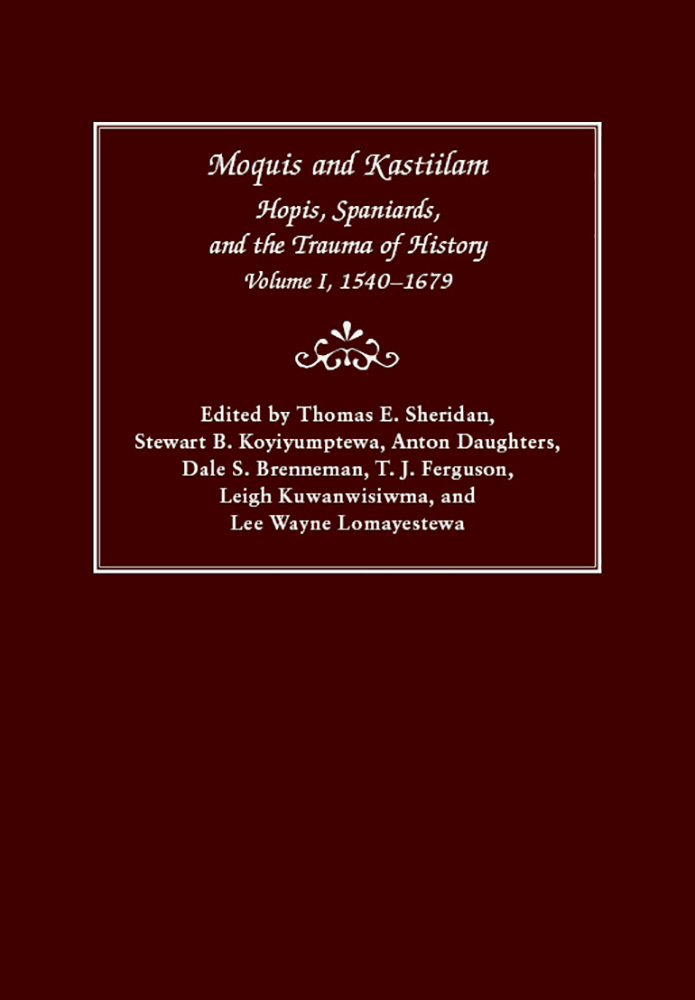Moquis and Kastiilam
Hopis, Spaniards, and the Trauma of History, Volume I, 1540–1679
Hardcover ($77.00), Ebook ($42.00)
Buy
The first of a two-volume series, Moquis and Kastiilam tells the story of the encounter between the Hopis, who the Spaniards called Moquis, and the Spaniards, who the Hopis called Kastiilam, from the first encounter in 1540 until the eve of the Pueblo Revolt of 1680. By comparing and contrasting Spanish documents with Hopi oral traditions, the editors portray a balanced presentation of their shared past. Translations of sixteenth-, seventeenth-, and eighteenth-century documents written by Spanish explorers, colonial officials, and Franciscan missionaries tell the perspectives of the European visitors, and oral traditions recounted by Hopi elders reveal the Indigenous experience.
The editors argue that the Spanish record is incomplete, and only the Hopi perspective can balance the story. The Spanish documentary record (and by extension the documentary record of any European or Euro-American colonial power) is biased and distorted, according to the editors, who assert there are enormous silences about Hopi responses to Spanish missionization and colonization. The only hope of correcting those weaknesses is to record and analyze Hopi oral traditions, which have been passed down from generation to generation, and give voice to Hopi values and Hopi social memories of what was a traumatic period in their past.
Spanish abuses during missionization—which the editors address specifically and directly as the sexual exploitation of Hopi women, suppression of Hopi ceremonies, and forced labor of Hopis—drove Hopis to the breaking point, inspiring a Hopi revitalization that led them to participate in the Pueblo Revolt. Those abuses, the revolt, and the resistance that followed remain as open wounds in Hopi society today.
The editors argue that the Spanish record is incomplete, and only the Hopi perspective can balance the story. The Spanish documentary record (and by extension the documentary record of any European or Euro-American colonial power) is biased and distorted, according to the editors, who assert there are enormous silences about Hopi responses to Spanish missionization and colonization. The only hope of correcting those weaknesses is to record and analyze Hopi oral traditions, which have been passed down from generation to generation, and give voice to Hopi values and Hopi social memories of what was a traumatic period in their past.
Spanish abuses during missionization—which the editors address specifically and directly as the sexual exploitation of Hopi women, suppression of Hopi ceremonies, and forced labor of Hopis—drove Hopis to the breaking point, inspiring a Hopi revitalization that led them to participate in the Pueblo Revolt. Those abuses, the revolt, and the resistance that followed remain as open wounds in Hopi society today.
“The compiling of many early references to the Hopis in a single source, and the inclusion of a Hopi perspective, make this work valuable to area specialists, anthropologists, and, it is hoped, the Hopi people themselves.”—Journal of Arizona History
“Thanks to an innovative collaboration between the Arizona State Museum’s Office of Ethnohistorical Research and the Hopi Tribe, Hopi voices are heard.”—New Mexico Historical Review
“A groundbreaking edition intertwining Hopi oral traditions—mostly dismissed in the past—with the Spanish documentary record.”—SMRC Revista
“An innovative and invaluable cultural transcript of the legendary Hopi people.”—Choice
“Placing historical Spanish and contemporary Indigenous perspectives in dialogue is really innovative. There is a growing literature about the need to reconcile historical and academic texts with Indigenous perspectives, but there are few examples of actual reconciliation. This book will be a heavily cited contribution to that literature.”—Wesley Bernardini, author of Hopi History in Stone: The Tutuveni Petroglyph Site
“A highly significant contribution to our understanding of Hopi history during the sixteenth and seventeenth centuries, because it helps to counter the phenomenon that historian Loma Ishii calls Hopi historicide: ‘the mass execution of Hopi intellect, agency, and epistemology.’”—Susan Deeds, author of Defiance and Deference in Mexico’s Colonial North: Indians under Spanish Rule in Nueva Vizcaya
“Thanks to an innovative collaboration between the Arizona State Museum’s Office of Ethnohistorical Research and the Hopi Tribe, Hopi voices are heard.”—New Mexico Historical Review
“A groundbreaking edition intertwining Hopi oral traditions—mostly dismissed in the past—with the Spanish documentary record.”—SMRC Revista
“An innovative and invaluable cultural transcript of the legendary Hopi people.”—Choice
“Placing historical Spanish and contemporary Indigenous perspectives in dialogue is really innovative. There is a growing literature about the need to reconcile historical and academic texts with Indigenous perspectives, but there are few examples of actual reconciliation. This book will be a heavily cited contribution to that literature.”—Wesley Bernardini, author of Hopi History in Stone: The Tutuveni Petroglyph Site
“A highly significant contribution to our understanding of Hopi history during the sixteenth and seventeenth centuries, because it helps to counter the phenomenon that historian Loma Ishii calls Hopi historicide: ‘the mass execution of Hopi intellect, agency, and epistemology.’”—Susan Deeds, author of Defiance and Deference in Mexico’s Colonial North: Indians under Spanish Rule in Nueva Vizcaya
 The University of Arizona Press
The University of Arizona Press

